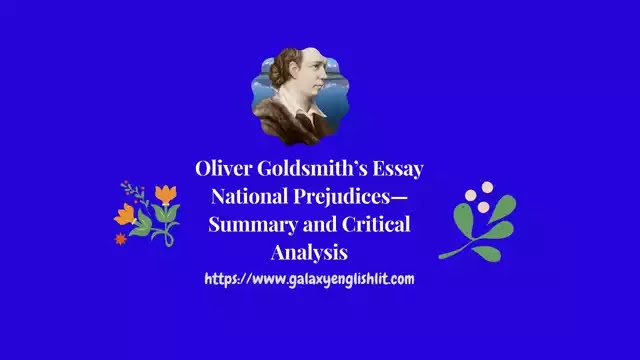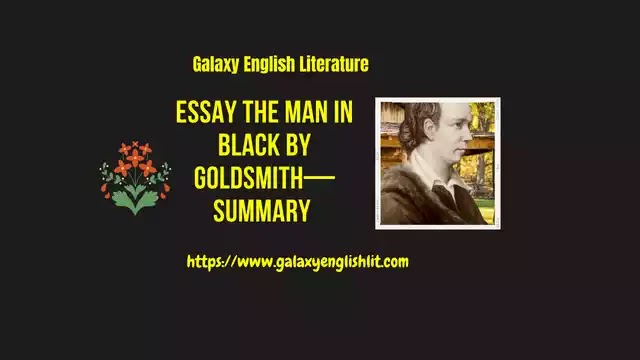Introduction:
W. B. Yeats, the Irish poet is one of the most prominent poets of the modern age. He harnessed his pen in the service of poetry for nearly fifty years. In fifty years he evolved from a dreamer to a realist and from a realist to a passionate metaphysical seer. Thought and passion drove him all his life. He was a poet all the time, and a great poet. Yeats' work is uniformly good even though he writes on such varied subjects as ancient legend, mythology, folklore, politics, history, love and individual friends and distinct events, and makes new myths of his own. His creative range is immense, he writes with perfect ease and mastery on themes taken from every possible sphere of life, and a high standard of performance is maintained throughout. He is a famous romantic poet. Like Wordsworth, Shelley and Keats, he loves Nature and inspires all to come back to Nature. He scorns the growing worldliness and wishes to escape from it. He is known his realistic and mystical poems also.
 |
| W. B. Yeats: Prominent Poet of the Modern Age |
His Important Works:
There is a mystical, dream like quality in the early poems to be found in The Wandering of Oisin (1899), Poems (1895), The Wind among the Reeds (1899), and The Shadowy Water (1900). From 1900 onwards there came a change in Yeats’ poetic outlook. The dreamer of dreams and the lover of old far - off things was shaken by the crude realities of life, and was drawn more and more of the vortex of giddy life. Poetry for Yeats was now no more an escape from reality but became a grappling with the stern realities of the world. The increasing realism of this period is clearly noticed in The Green Helmet and Other Poems (1910), Responsibilities (1914). The Irish troubles of 1916 and the Great War of 1914-1918 brought a change in his outlook and made him grim, gloomy, sorrowful and philosophical in his poetry. The Wild Swans at Coole, The Tower (1928), The Winding Stair and Other Poems (1933), New Poems (1938), Last Poems (1939) reveal tension between the dreamer and the man of affairs, between the poetic and the practical life.
His Mysticism:
Mystic note runs through Yeats' poetry from the beginning to end of his career. The world of Yeats' poetry is the world of a mystic visionary in which the gods and fairies of Celtic mythology live again. He was convinced of the realities of the fairies and other supernatural beings. He also believed in magic and the occult. Yeats loved occultism and comprehended significance of spiritual world, magic, mysteries and meditation. His study of Plato and Plotinus deepened and widened his mystic vision. Yeats had his own convictions, but he searched for a pattern or a system which may give form and coherence to his beliefs. This led him to magic, to astronomy, and to other occult studies. At last he succeeded in formulating a system of his own. Yeats believes that the process of history is cyclic one. It is like the movement of rapidly rotating gyres or cones. He believes that the present cycle of history is almost over. A new civilization is to be born out of the ruins of the older one.
The Use of Symbols:
Yeats was a symbolist from the beginning to the end of his career. In the early phase of his career, his symbols are elementary and are no obstacles in the way of the meaning. A number of his early poems are organised round 'the rose' symbol. But as the years passed on, his symbols became complex, personal and complicated. He made use of symbols to convey his inner sensations, his visions, and trances, and his mystic experiences. Yeats' symbols are highly evocative and suggestive. His dominant or obsessive symbols are tree, bird, tower, sea, house, mask and rose. He employs 'tree' as a symbol for age, sterility and reality, yet the tree can sprout again and renew itself, and is thus able "to spit in the face of time". Similarly birds suggested to him a host of meanings, speed, lightness, freedom, flight, quickness of intellect. Other symbols which abound in his mature poetry are Sun, Moon, Silver, Gold, dancer, wheel, gyre, spern, arrow, etc.
The Use of Myths:
Richly gifted with a mythopoeic imagination, Yeats is forever finding analogies for the present and the personal in the past. He glorifies the present and exalts and imparts the universal significance of a myth. In the very opening of The Easter (1916), for example, we get the myth of Yeats' contemporaries coming out of the dead past to participate in the activity of the present. In The Magi the old Biblical story has been modified and the Magi are transformed to stars looking down at the 'bestial floor.' In No Second Troy and a host of other poems, the old Helen-myth has been infused with unique personal significance.
His Nationalism:
He is rightly the National and Nationalistic poet of Ireland as well as the poet of Celtic Twilight. Ireland is always in the mind of the poet when he is writing. His poems like Fergus and the Druid, Cuchulaine's Fight with the Sea, The Song of Wandering Aengus, An Irish Airman Foresees His Death, Easter 1916, and a number of others are based on Irish politics. Yeats’ love for and interest in Irish nationalism was fostered and fanned by his ancestry.
Personal Elements:
Yeats’ poetry and his biography are closely interwoven. A large number of his poems are based directly upon actual events in his life, including his friendships and relationship. The poem A Prayer for My Daughter is a deeply personal poem expressing the poet's hopes and fears about the future of his daughter, Anne. Sailing to Byzantium is also a personal poem in so far as it deals with the problem of old age which always haunted Yeats. Among School Children is a record of his thoughts and feelings on the occasion of his visit to a convent school in the capacity of a member of the Irish Senate, “a sixty - year - old smiling public man”. The Municipal Gallery Revisited is among the poems connected closely with his own life and the lives of his friends .
His Lyrical Genius:
Yeats was essentially lyrical. If he began his poetic career with dramatic poetry, it was because of his father's wish that preferred dramatic poetry to lyrical. He wrote lyrics of several kinds. These lyrics of Yeats can broadly be divided into four categories: First, Lyrics of Escape, Second, Political Lyrics, Third, Lyrics of Reminiscence, and Four, Love Lyrics. His early lyrics like The Song of the Happy Shepherd, The Stolen Child, etc., take us to a dream-world where the characters dance with fairies and enjoy the pleasures of fairyland. His early volumes of verses, The Crossways (1899), and The Rose (1893) include some of his finest and most widely anthologized lyrics.
His Love of Nature:
Nature captivates Yeats' mind, but it is not a mystic. He does not find any spiritual meaning in Nature. He is elated and exalted at the sight of Nature's loveliness. He gives an exquisite picture of birds, clouds, landscapes, sea and countryside in his poetry. He cannot forget Sligo and the beautiful landscape of his mother's house in Ireland. He regards nature as the source of peace and consolation. He, therefore, decides to go to the lake country of Innisfree and settle there. He would make there a modest cottage for shelter and grow beans and rear honey-bees for his livelihood. He would enjoy the peace of Nature coming drop by drop. He writes:
"And I shall have some peace there, for peace comes dropping slow,
Dropping from the veils of the morning to where the cricket sings.”
His Craftsmanship:
Yeats had two main methods of poetic creation: one spontaneous and the other a laborious process involving much alteration. and substitution. He was a conscious artist who polished and repolished his verse. His poems have intensity and complexity of a careful artist. His mythological and romantic poems are quite simple. Yet they are complex not in matters of language or diction but in respect of thought. Yeats, however, soon began to feel dissatisfied with this early style, and his early poems were revised and modified both in syntax and vocabulary.
In the matter of vocabulary also, there is ever an attempt to approximate to common speech. Archaisms and poeticisms are gradually shed and the words acquire a harder texture. Images grow more definite and precise, solid and firm. Yeats is a metrical artist of consummate skill. He experimented with various metres and stanza-forms. He contributed a great deal in freeing the English lyric from the tyranny of the Iambic, and manipulated the stress, pause and cadence of the long line with great mastery and self-confidence. The octosyllabic couplet he made particularly his own and brought out its full colloquial possibilities. He had a Donne-like command over stanza structures and made his stanza-patterns correspond with the movement of thought and emotion. The sudden shifts in tone and mood, often within the same line, further indicate Yeats' affinity with Donne and his school.





